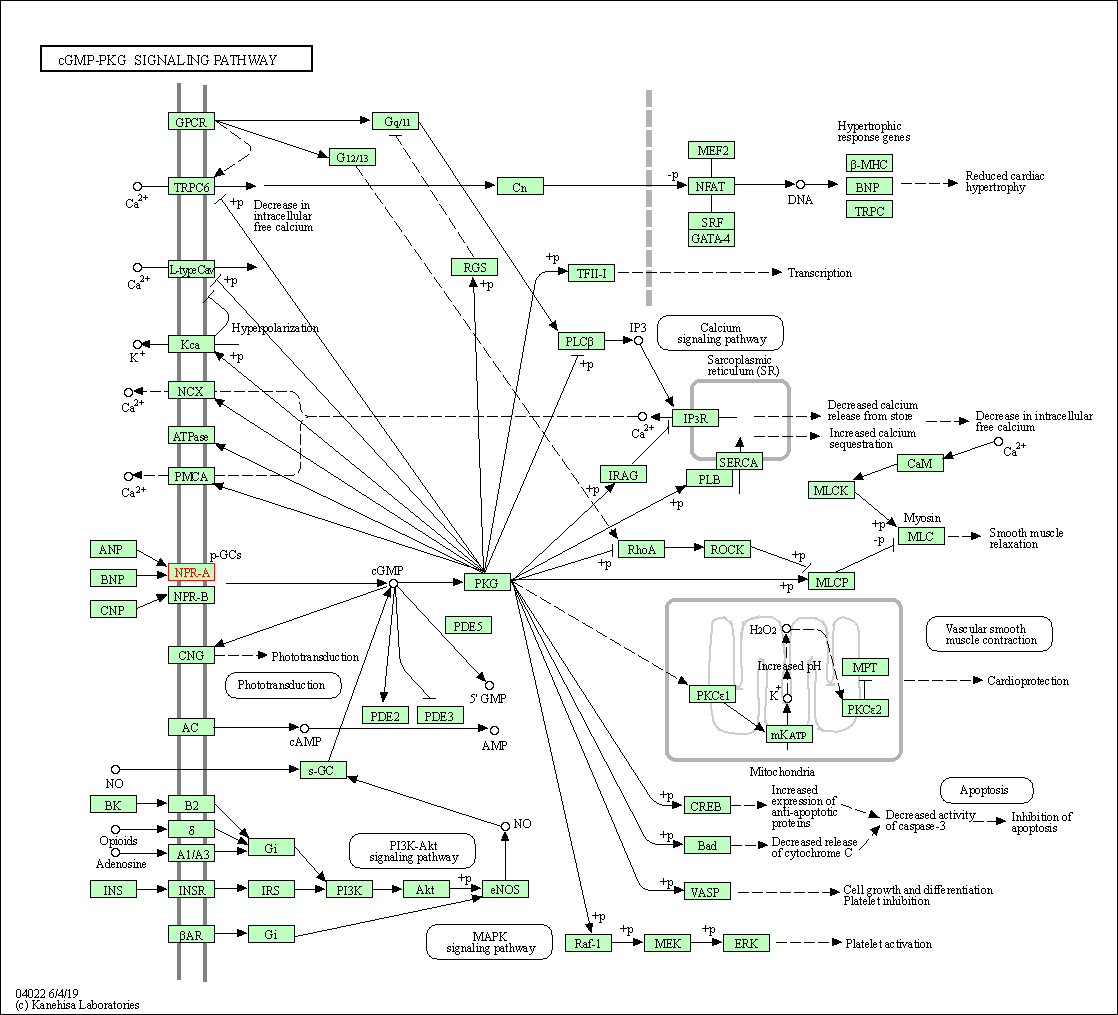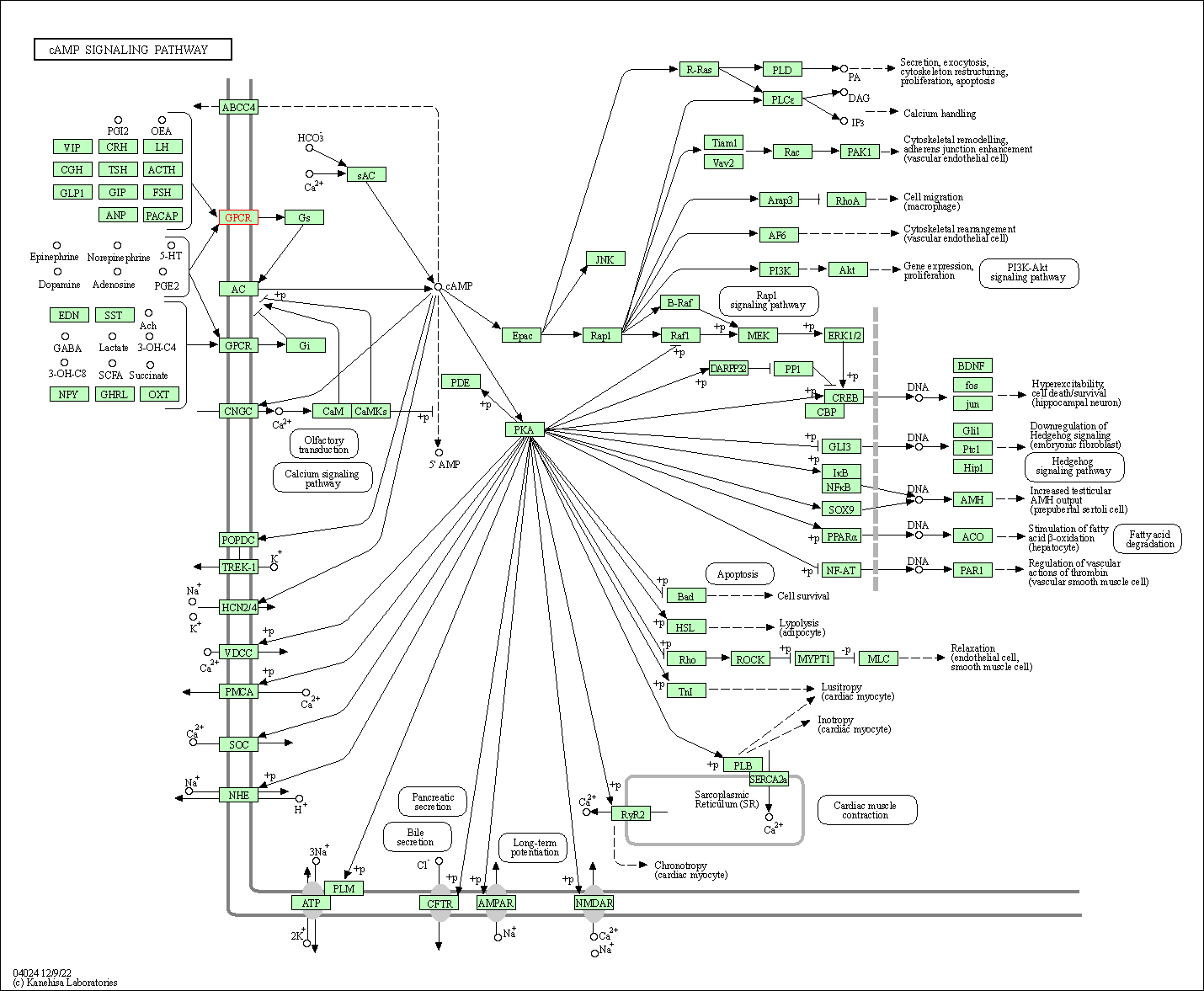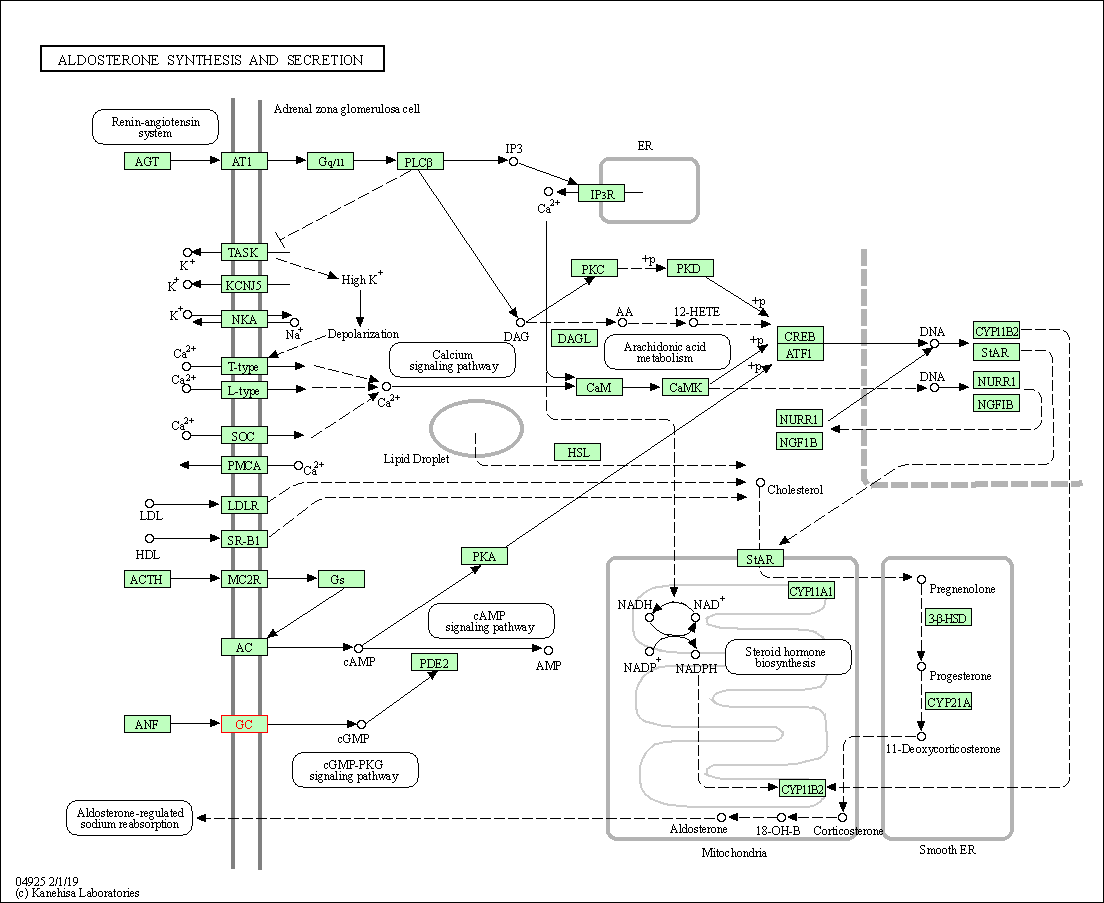Target Information
| Target General Information | Top | |||||
|---|---|---|---|---|---|---|
| Target ID |
T71230
(Former ID: TTDS00478)
|
|||||
| Target Name |
Atrial natriuretic peptide receptor A (NPR1)
|
|||||
| Synonyms |
NPR1; NPR-A; GC-A; Atrial natriuretic peptide A-type receptor; ANPRA; ANP-A
Click to Show/Hide
|
|||||
| Gene Name |
NPR1
|
|||||
| Target Type |
Successful target
|
[1] | ||||
| Disease | [+] 1 Target-related Diseases | + | ||||
| 1 | Heart failure [ICD-11: BD10-BD1Z] | |||||
| Function |
Receptor for the atrial natriuretic peptide NPPA/ANP and the brain natriuretic peptide NPPB/BNP which are potent vasoactive hormones playing a key role in cardiovascular homeostasis. Has guanylate cyclase activity upon binding of the ligand.
Click to Show/Hide
|
|||||
| BioChemical Class |
Phosphorus-oxygen lyase
|
|||||
| UniProt ID | ||||||
| EC Number |
EC 4.6.1.2
|
|||||
| Sequence |
MPGPRRPAGSRLRLLLLLLLPPLLLLLRGSHAGNLTVAVVLPLANTSYPWSWARVGPAVE
LALAQVKARPDLLPGWTVRTVLGSSENALGVCSDTAAPLAAVDLKWEHNPAVFLGPGCVY AAAPVGRFTAHWRVPLLTAGAPALGFGVKDEYALTTRAGPSYAKLGDFVAALHRRLGWER QALMLYAYRPGDEEHCFFLVEGLFMRVRDRLNITVDHLEFAEDDLSHYTRLLRTMPRKGR VIYICSSPDAFRTLMLLALEAGLCGEDYVFFHLDIFGQSLQGGQGPAPRRPWERGDGQDV SARQAFQAAKIITYKDPDNPEYLEFLKQLKHLAYEQFNFTMEDGLVNTIPASFHDGLLLY IQAVTETLAHGGTVTDGENITQRMWNRSFQGVTGYLKIDSSGDRETDFSLWDMDPENGAF RVVLNYNGTSQELVAVSGRKLNWPLGYPPPDIPKCGFDNEDPACNQDHLSTLEVLALVGS LSLLGILIVSFFIYRKMQLEKELASELWRVRWEDVEPSSLERHLRSAGSRLTLSGRGSNY GSLLTTEGQFQVFAKTAYYKGNLVAVKRVNRKRIELTRKVLFELKHMRDVQNEHLTRFVG ACTDPPNICILTEYCPRGSLQDILENESITLDWMFRYSLTNDIVKGMLFLHNGAICSHGN LKSSNCVVDGRFVLKITDYGLESFRDLDPEQGHTVYAKKLWTAPELLRMASPPVRGSQAG DVYSFGIILQEIALRSGVFHVEGLDLSPKEIIERVTRGEQPPFRPSLALQSHLEELGLLM QRCWAEDPQERPPFQQIRLTLRKFNRENSSNILDNLLSRMEQYANNLEELVEERTQAYLE EKRKAEALLYQILPHSVAEQLKRGETVQAEAFDSVTIYFSDIVGFTALSAESTPMQVVTL LNDLYTCFDAVIDNFDVYKVETIGDAYMVVSGLPVRNGRLHACEVARMALALLDAVRSFR IRHRPQEQLRLRIGIHTGPVCAGVVGLKMPRYCLFGDTVNTASRMESNGEALKIHLSSET KAVLEEFGGFELELRGDVEMKGKGKVRTYWLLGERGSSTRG Click to Show/Hide
|
|||||
| 3D Structure | Click to Show 3D Structure of This Target | AlphaFold | ||||
| ADReCS ID | BADD_A00948 | |||||
| Drugs and Modes of Action | Top | |||||
|---|---|---|---|---|---|---|
| Approved Drug(s) | [+] 1 Approved Drugs | + | ||||
| 1 | Nesiritide | Drug Info | Approved | Congestive heart failure | [2] | |
| Clinical Trial Drug(s) | [+] 4 Clinical Trial Drugs | + | ||||
| 1 | Ularitide | Drug Info | Phase 3 | Heart failure | [3], [4] | |
| 2 | Ataciguat | Drug Info | Phase 2 | Neuropathic pain | [5], [6] | |
| 3 | Cenderitide | Drug Info | Phase 2 | Heart disease | [7] | |
| 4 | PL-3994 | Drug Info | Phase 2 | Hypertension | [8] | |
| Mode of Action | [+] 4 Modes of Action | + | ||||
| Binder | [+] 1 Binder drugs | + | ||||
| 1 | Nesiritide | Drug Info | [1] | |||
| Modulator | [+] 1 Modulator drugs | + | ||||
| 1 | Ularitide | Drug Info | [9] | |||
| Activator | [+] 1 Activator drugs | + | ||||
| 1 | Ataciguat | Drug Info | [10] | |||
| Agonist | [+] 2 Agonist drugs | + | ||||
| 1 | Cenderitide | Drug Info | [11] | |||
| 2 | PL-3994 | Drug Info | [12] | |||
| Cell-based Target Expression Variations | Top | |||||
|---|---|---|---|---|---|---|
| Cell-based Target Expression Variations | ||||||
| Different Human System Profiles of Target | Top |
|---|---|
|
Human Similarity Proteins
of target is determined by comparing the sequence similarity of all human proteins with the target based on BLAST. The similarity proteins for a target are defined as the proteins with E-value < 0.005 and outside the protein families of the target.
A target that has fewer human similarity proteins outside its family is commonly regarded to possess a greater capacity to avoid undesired interactions and thus increase the possibility of finding successful drugs
(Brief Bioinform, 21: 649-662, 2020).
Human Tissue Distribution
of target is determined from a proteomics study that quantified more than 12,000 genes across 32 normal human tissues. Tissue Specificity (TS) score was used to define the enrichment of target across tissues.
The distribution of targets among different tissues or organs need to be taken into consideration when assessing the target druggability, as it is generally accepted that the wider the target distribution, the greater the concern over potential adverse effects
(Nat Rev Drug Discov, 20: 64-81, 2021).
Human Pathway Affiliation
of target is determined by the life-essential pathways provided on KEGG database. The target-affiliated pathways were defined based on the following two criteria (a) the pathways of the studied target should be life-essential for both healthy individuals and patients, and (b) the studied target should occupy an upstream position in the pathways and therefore had the ability to regulate biological function.
Targets involved in a fewer pathways have greater likelihood to be successfully developed, while those associated with more human pathways increase the chance of undesirable interferences with other human processes
(Pharmacol Rev, 58: 259-279, 2006).
Biological Network Descriptors
of target is determined based on a human protein-protein interactions (PPI) network consisting of 9,309 proteins and 52,713 PPIs, which were with a high confidence score of ≥ 0.95 collected from STRING database.
The network properties of targets based on protein-protein interactions (PPIs) have been widely adopted for the assessment of target’s druggability. Proteins with high node degree tend to have a high impact on network function through multiple interactions, while proteins with high betweenness centrality are regarded to be central for communication in interaction networks and regulate the flow of signaling information
(Front Pharmacol, 9, 1245, 2018;
Curr Opin Struct Biol. 44:134-142, 2017).
Human Similarity Proteins
Human Tissue Distribution
Human Pathway Affiliation
Biological Network Descriptors
|
|
|
Note:
If a protein has TS (tissue specficity) scores at least in one tissue >= 2.5, this protein is called tissue-enriched (including tissue-enriched-but-not-specific and tissue-specific). In the plots, the vertical lines are at thresholds 2.5 and 4.
|
| KEGG Pathway | Pathway ID | Affiliated Target | Pathway Map |
|---|---|---|---|
| Purine metabolism | hsa00230 | Affiliated Target |

|
| Class: Metabolism => Nucleotide metabolism | Pathway Hierarchy | ||
| cGMP-PKG signaling pathway | hsa04022 | Affiliated Target |

|
| Class: Environmental Information Processing => Signal transduction | Pathway Hierarchy | ||
| cAMP signaling pathway | hsa04024 | Affiliated Target |

|
| Class: Environmental Information Processing => Signal transduction | Pathway Hierarchy | ||
| Vascular smooth muscle contraction | hsa04270 | Affiliated Target |

|
| Class: Organismal Systems => Circulatory system | Pathway Hierarchy | ||
| Thermogenesis | hsa04714 | Affiliated Target |

|
| Class: Organismal Systems => Environmental adaptation | Pathway Hierarchy | ||
| Oxytocin signaling pathway | hsa04921 | Affiliated Target |

|
| Class: Organismal Systems => Endocrine system | Pathway Hierarchy | ||
| Regulation of lipolysis in adipocytes | hsa04923 | Affiliated Target |

|
| Class: Organismal Systems => Endocrine system | Pathway Hierarchy | ||
| Renin secretion | hsa04924 | Affiliated Target |

|
| Class: Organismal Systems => Endocrine system | Pathway Hierarchy | ||
| Aldosterone synthesis and secretion | hsa04925 | Affiliated Target |

|
| Class: Organismal Systems => Endocrine system | Pathway Hierarchy | ||
| Click to Show/Hide the Information of Affiliated Human Pathways | |||
| Degree | 3 | Degree centrality | 3.22E-04 | Betweenness centrality | 1.35E-04 |
|---|---|---|---|---|---|
| Closeness centrality | 1.61E-01 | Radiality | 1.24E+01 | Clustering coefficient | 0.00E+00 |
| Neighborhood connectivity | 4.67E+00 | Topological coefficient | 5.24E-01 | Eccentricity | 13 |
| Download | Click to Download the Full PPI Network of This Target | ||||
| Chemical Structure based Activity Landscape of Target | Top |
|---|---|
| Drug Property Profile of Target | Top | |
|---|---|---|
| (1) Molecular Weight (mw) based Drug Clustering | (2) Octanol/Water Partition Coefficient (xlogp) based Drug Clustering | |
|
|
||
| (3) Hydrogen Bond Donor Count (hbonddonor) based Drug Clustering | (4) Hydrogen Bond Acceptor Count (hbondacc) based Drug Clustering | |
|
|
||
| (5) Rotatable Bond Count (rotbonds) based Drug Clustering | (6) Topological Polar Surface Area (polararea) based Drug Clustering | |
|
|
||
| "RO5" indicates the cutoff set by lipinski's rule of five; "D123AB" colored in GREEN denotes the no violation of any cutoff in lipinski's rule of five; "D123AB" colored in PURPLE refers to the violation of only one cutoff in lipinski's rule of five; "D123AB" colored in BLACK represents the violation of more than one cutoffs in lipinski's rule of five | ||
| Target Poor or Non Binders | Top | |||||
|---|---|---|---|---|---|---|
| Target Poor or Non Binders | ||||||
| References | Top | |||||
|---|---|---|---|---|---|---|
| REF 1 | The efficacy and safety of B-type natriuretic peptide (nesiritide) in patients with renal insufficiency and acutely decompensated congestive heart failure. Nephrol Dial Transplant. 2004 Feb;19(2):391-9. | |||||
| REF 2 | Drugs@FDA. U.S. Food and Drug Administration. U.S. Department of Health & Human Services. 2015 | |||||
| REF 3 | URL: http://www.guidetopharmacology.org Nucleic Acids Res. 2015 Oct 12. pii: gkv1037. The IUPHAR/BPS Guide to PHARMACOLOGY in 2016: towards curated quantitative interactions between 1300 protein targets and 6000 ligands. (Ligand id: 8446). | |||||
| REF 4 | ClinicalTrials.gov (NCT01661634) Efficacy and Safety of Ularitide for the Treatment of Acute Decompensated Heart Failure. U.S. National Institutes of Health. | |||||
| REF 5 | URL: http://www.guidetopharmacology.org Nucleic Acids Res. 2015 Oct 12. pii: gkv1037. The IUPHAR/BPS Guide to PHARMACOLOGY in 2016: towards curated quantitative interactions between 1300 protein targets and 6000 ligands. (Ligand id: 5141). | |||||
| REF 6 | ClinicalTrials.gov (NCT00799656) Efficacy and Safety Study of Ataciguat Versus Placebo in Patients With Neuropathic Pain. U.S. National Institutes of Health. | |||||
| REF 7 | Cenderitide (CD-NP), a novel peptide designed to activate both guanylyl cyclase B and A, activates the second messenger cGMP, suppresses aldosterone, and preserves GFR without reducing blood pressurein a proof-of-concept study in patients with chronic heart failure. BMC Pharmacol. 2011; 11(Suppl 1): P18. | |||||
| REF 8 | ClinicalTrials.gov (NCT00686803) Safety Study of Subcutaneously Administered PL-3994 in Subjects With Controlled Hypertension. U.S. National Institutes of Health. | |||||
| REF 9 | Ularitide for the treatment of acute decompensated heart failure: from preclinical to clinical studies. Eur Heart J. 2015 Mar 21;36(12):715-23. | |||||
| REF 10 | Pharma & Vaccines. Product Development Pipeline. April 29 2009. | |||||
| REF 11 | 2011 Pipeline of Nile Therapeutics. | |||||
| REF 12 | In vitro and in vivo pharmacological profile of PL-3994, a novel cyclic peptide (Hept-cyclo(Cys-His-Phe-d-Ala-Gly-Arg-d-Nle-Asp-Arg-Ile-Ser-Cys)-Tyr-[Arg mimetic]-NH2) natriuretic peptide receptor-A agonist that is resistant to neutral endopeptidase and acts as a bronchodilator. Pulm Pharmacol Ther. 2013 April; 26(2): 229-238. | |||||
If You Find Any Error in Data or Bug in Web Service, Please Kindly Report It to Dr. Zhou and Dr. Zhang.

